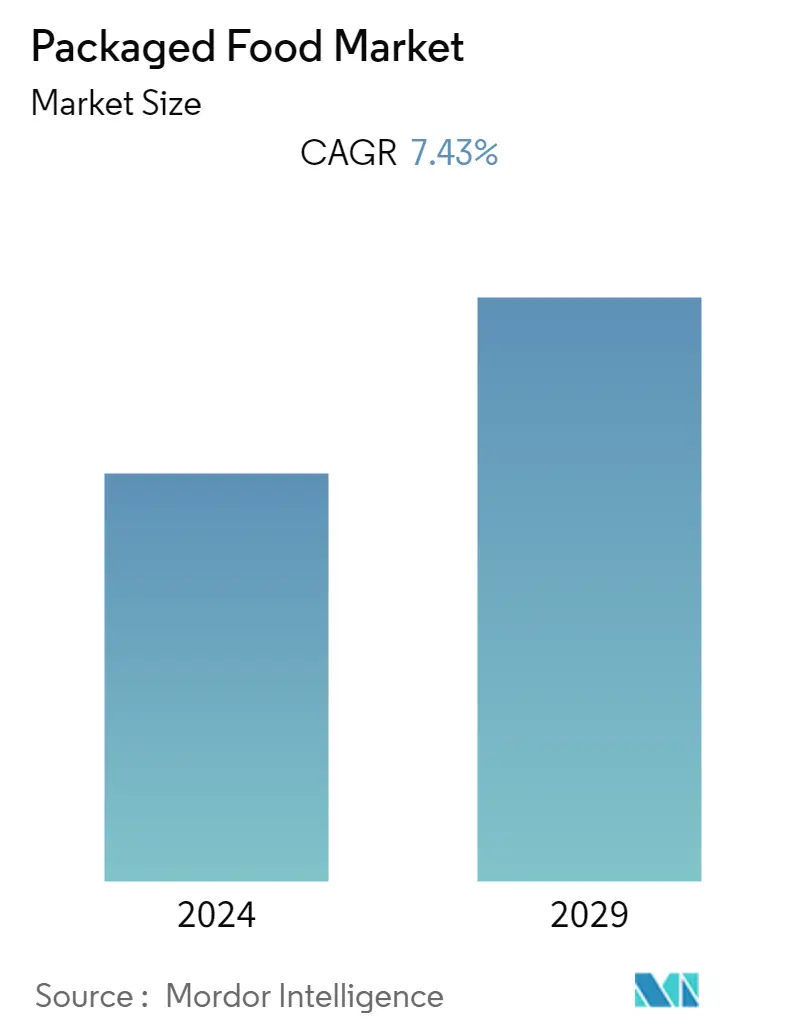Market Size of Packaged Food Industry

| Study Period | 2019 - 2029 |
| Base Year For Estimation | 2023 |
| Forecast Data Period | 2024 - 2029 |
| CAGR | 7.43 % |
| Fastest Growing Market | Asia Pacific |
| Largest Market | North America |
| Market Concentration | Low |
Major Players.webp)
*Disclaimer: Major Players sorted in no particular order |
Packaged Food Market Analysis
The global packaged food market is expected to register a CAGR of 7.43% during the forecast period.
- The rising preference toward convenience products fuels the growing demand for packaged food products due to their effortless and time-saving beneficial factor compared to cooking from scratch. The packaged food market is growing abundantly owing to the rising volume of the hectic lifestyle of the working population around the globe, which is majorly boosting the packaged food market.
- According to the World Bank, China has 61.61% female labor participation in 2021. These trends have made packaged foods a vital part of families' pantries worldwide. Packaged foods like frozen ones are becoming increasingly popular in Europe as a side dish or meal replacement. The market for packaged foods is anticipated to grow due to the rising snacking trend, especially among adults and teenagers, and snack frequency among these population groups.
- Furthermore, the continuously burgeoning packaged food industry of the global market is driven by continuous innovation in the market, supported by augmenting consumer demand. For instance, in April 2022, Nestle's brand DiGiorno launched Stuffed Pizza Bites-snack-sized rolls of its flagship pizza made with 100% real cheese. New DiGiorno Stuffed Pizza Bites are available in four varieties and can be prepared in the oven, air fryer, or microwave depending on your crust preference - pepperoni, supreme, three meat, and four cheese
- More players entering the market are further boosting the growth of the market. Specific consumer-based demands such as plant-based food, vegan food, dairy-free products, and others are also propelling the growth of the market, for it creates opportunities for the players to expand their product portfolio to cater to such specific requirements. Moreover, factors such as on-the-go healthy snacking are insisting the players introduce a wide range of meat snacks, cereal, and granola bars. Thus, the healthy snacking sector of the market is growing at a considerable level.
Packaged Food Industry Segmentation
Packaged foods are convenience foods produced commercially and distributed for consumer use. The packaging does not just keep food protected to maintain its aesthetic appeal. It also keeps the food fresh so that the taste and quality of the product stay intact. It ensures that the food retains a good shelf life, too, so that customers can keep the item for a set period before it needs to be consumed.
The global packaged food market is segmented by type, packaging type, distribution channel, and geography. By type, the market is segmented into dairy products, confectionery, beverages, bakery, snacks, meat, poultry and seafood, breakfast cereals, ready meals, and other product types. By packaging type, the market is segmented into plastic packaging, tetra pack, metal cans, and other package types. By distribution channel, the market is segmented into supermarkets/hypermarkets, specialty stores, convenience stores, online retail stores, and other distribution channels. By geography, the market is segmented into North America, Europe, Asia-Pacific, South America, and Middle East & Africa.
The market sizing has been done in value terms in USD for all the abovementioned segments.
| Product Type | |
| Packaging Type | |
| Distribution Channel | |
| Geography | |||||||||
| |||||||||
| |||||||||
| |||||||||
|
Packaged Food Market Size Summary
The global packaged food industry is experiencing significant growth, driven by the increasing demand for convenience products that cater to the fast-paced lifestyles of consumers worldwide. This trend is particularly evident in regions like Europe, where frozen foods are gaining popularity as meal replacements or side dishes. The market's expansion is further fueled by continuous innovation and the introduction of new products that meet evolving consumer preferences, such as plant-based and vegan options. The rise of snacking, especially among adults and teenagers, is also contributing to the market's growth, as consumers seek quick and easy food solutions that align with their busy schedules. The industry's dynamic nature is supported by the entry of new players and the diversification of product offerings to include healthier and more sustainable options.
In addition to convenience, the demand for plant-based foods is on the rise, driven by a growing awareness of health and sustainability among consumers. This shift is particularly notable in regions like Asia-Pacific, where there is a strong preference for low-calorie, high-protein products free from artificial additives. The increasing prevalence of lactose intolerance and allergies related to animal-based products has further propelled the demand for dairy-free and plant-based alternatives. Major players in the packaged food market, such as Nestle, Coca-Cola, and PepsiCo, are actively expanding their product portfolios to cater to these trends, leveraging strategies like product innovation and geographical expansion. The market's fragmentation and the presence of key players engaging in strategic partnerships and acquisitions highlight the competitive landscape and the ongoing efforts to meet the diverse needs of health-conscious consumers.
Packaged Food Market Size - Table of Contents
-
1. MARKET DYNAMICS
-
2. MARKET SEGMENTATION
Packaged Food Market Size FAQs
What is the current Packaged Food Market size?
The Packaged Food Market is projected to register a CAGR of 7.43% during the forecast period (2025-2030)
Who are the key players in Packaged Food Market?
Nestle SA, PepsiCo, Inc., The Coca-Cola Company, General Mills Inc. and Mondelez International are the major companies operating in the Packaged Food Market.

